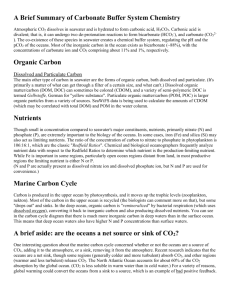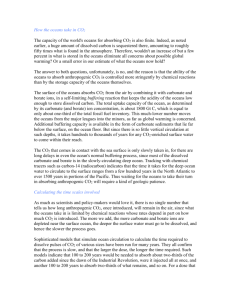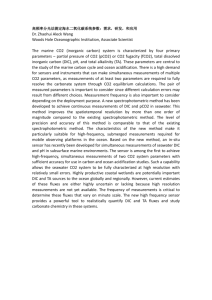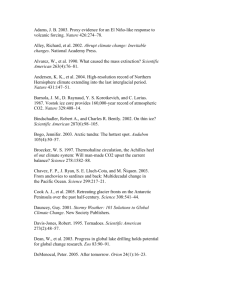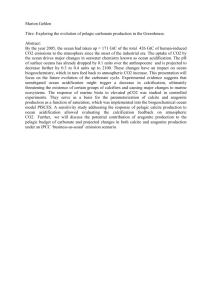Week 9a
advertisement
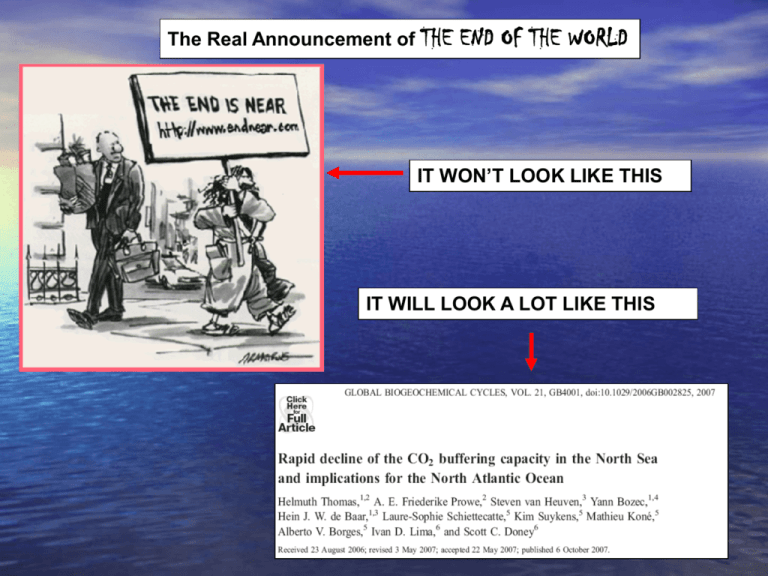
The Real Announcement of THE END OF THE WORLD IT WON’T LOOK LIKE THIS IT WILL LOOK A LOT LIKE THIS Ocean Acidification – a new kind of ‘sea sickness’. The Global Crisis that you haven’t heard about (yet)! Worldwide emissions of carbon dioxide from fossil fuel burning are dramatically altering ocean chemistry and threatening marine organisms, including corals, that secrete skeletal structures and support oceanic biodiversity. The oceans – worldwide – have absorbed approximately 11 billion metric tons of carbon between 1800 and 1994. The addition of all this CO2 to the upper oceans is changing its chemistry, and making it more ‘acidic’. CO2 + H2O ⇌ H2CO3 (or ‘carbonic acid’) It is what makes your Coke/Pepsi fizz. Some basic chemistry first The term pH describes the acidity of a liquid. It is defined as: pH = –log10 [H+] Which means that if hydrogen ions increase by X 10, the pH decreases (becomes MORE acidic) by 1 unit. Water (H2O) splits into [H+] and [OH-], and in pure water these are equal (and equal to 10-7 moles/liter) and the pH is therefore 7.0 H2O => [H+] + [OH-] Acid solutions are <7.0. Alkaline (basic) solutions have excess [OH-] and are > 7.0 (up to pH of 14). On the logarithmic pH scale used to measure acidity, seawater near the ocean surface averages about 8.2. Pure water—neither acidic nor basic—has a pH close to 7.0. coffee, has a pH about 5.0; lemon juice has a pH of around 2.4; laundry bleach, a pH around 12.5. About 50% of the CO2 that humans put into the atmosphere by burning fossil fuels ends up being quickly dissolved in the oceans. The remaining 50% of the CO2 stays in the atmosphere, causing the increase in this greenhouse gas by about ONLY 2 ppm per year. If the Ocean didn’t absorb this large quantity, atmospheric CO2 levels would rise twice as fast – at 4 ppm per year instead of 2 ppm. Carbon dioxide dissolved in seawater first reacts with the water molecule (H2O) to form carbonic acid (H2CO3). CO2 + H2O = H2CO3 BUT, not all the CO2 dissolved in seawater reacts to make carbonic acid and therefore seawater contains dissolved gaseous CO2 (as in carbonated soda drinks). Carbonic acid is an acid and splits up into its constituents, releasing an excess of H+ to solution and so driving pH towards lower values. Carbonic acid splits up by adding one [H+] to solution along with HCO3– (a bicarbonate ion): [H2CO3] ⇒[H+] + [HCO3–] Dissolved inorganic carbon (DIC) in seawater As CO2 dissolves in seawater, the reaction with water produces both [H+] and two negatively charged forms of dissolved carbon; i.e., HCO3- (bicarbonate) and CO3-2 (carbonate) At the typical pH of seawater (about 8.2), these are present as 90% as HCO3- (bicarbonate) 9% as CO3-2 (carbonate) <1% as CO2 (carbon dioxide gas) 90% as HCO3- 9% as CO3-2 <1% as CO2 We are here We are going here Relative proportions of the three inorganic forms of CO2 dissolved in seawater. Note the ordinatescale (vertical axis) is plotted logarithmically. The increase in [H+] causes some CO32– (called carbonate ion) to react with [H+] to become HCO3– : [H+] + [CO32–] ⇒[HCO3–] (bicarbonate) IMPORTANT conclusion… The net effect of the dissolution of CO2 in seawater is to increase concentrations of [H+], H2CO3 and HCO3–, while decreasing concentrations of CO32–. The decrease in carbonate ion concentration [CO32–] has important consequences for the chemistry of carbonate minerals commonly used by marine biota to form shells or skeletons. The formation and dissolution of carbonate minerals can be represented as: ←mineral formation (the animal does this) CaCO3 ⇔[Ca2+] + [CO32–] dissolution→ (thermodynamics does this) Because the dissolution of CO2 in seawater decreases [CO32–], this reaction moves to the right, impeding the formation of carbonate minerals and promoting their dissolution. Note that the dissolution of carbonate minerals tends to decrease [H+] (i.e., increase pH), counteracting some of the pH effects of added CO2. The “carbonate buffer” effect. The term ‘carbonate buffer’ describes how the dissolved inorganic carbon system in seawater acts to diminish changes in ocean [H+] concentration, and thus pH. If a process, such as CO2 dissolution, adds [H+] to seawater, some of the added [H+] reacts with carbonate (CO32–) ion to convert it to bicarbonate (HCO3–). Because most of the added [H+] would be consumed in this way, the change in pH is much less than it would otherwise be. But this process also consumes some carbonate ion; therefore this pH buffering capacity would diminish as CO2 concentrations increase. Because CO2 is absorbed at the sea surface, it is the surface oceans that are most affected. On the longer time scales of ocean mixing, interaction with CaCO3 - rich sediments tends to buffer the chemistry of the seawater so that changes in pH are lessened. For example, if the deep oceans start to become more acidic such as through the addition of CO2, which decreases concentrations of CO32–, some carbonate ion will be dissolved from sediments. Diagram of the carbonate buffer and biological pump in the surface oceans. After absorption of CO2 into the oceans, it is converted by the carbonate buffer. seafloor Calcification in the oceans also releases CO2 , some of which is returned to the atmosphere. The biological pump (descending wiggly arrows) converts CO2 from the atmosphere into organic carbon (Corg) and CaCO3 and transfers it to the deep ocean waters and sediments. (i.e., removes it from the upper ocean and ATM inventories). Calcite dissolution occurs at depths in the range of about 1.5 to 5 km and aragonite dissolves at depths in the range of about 0.5 to 2.5 km. There is a critical concentration of carbonate ions in seawater (the saturation concentration) below which CaCO3 will start to dissolve (the CCD). Because CaCO3 solubility increases with decreasing temperature and increasing pressure, the critical concentration occurs at a depth, the ‘saturation horizon’, below which seawater is under-saturated and CaCO3 will tend to dissolve and above which seawater is super-saturated and CaCO3 will tend to be preserved. With increasing atmosphere CO2, the ocean becomes more acidic, and the CCD (where sediments can store carbonate) becomes shallower. Because added CO2 decreases the carbonate ion concentration, the saturation horizons will become shallower with increasing releases of human derived CO2 to the atmosphere. That is – the CCD will rise to shallower depths – and it is. During the 19th and 20th centuries, the surface ocean’s uptake capacity for CO2 was large and this allowed the ocean to absorb enormous amounts of CO2 from the atmosphere - without a proportional increase of the pCO2 of the ocean’s surface waters. The amount of CO2 taken up by the oceans per year since 1850.. in gigatons/year. The average American emits about 120 pounds of CO2 per day. About 5 times the world average. 120 x 365 days = 43,800 lbs = 21.9 tons. PREVIOUSLY, the oceans could absorb could about 40 pounds of CO2 per day per person. But this is all starting to change. RECENT INCREASES IN CO2 VALUES: upper => ATM: lower => OCEAN Present surface seawater pH values from all oceans (pH calculated from dissolved inorganic carbon and alkalinity). The majority of the data fall into narrow pH range of 8.1 ± 0.1. Also shown are typical pH ranges of glacial, pre-industrial, present, and future (year 2100) surface seawaters resulting from the observed and predicted increase in atmospheric CO2 levels (blue line with exponential increase) as obtained by simple scenario calculation. PAST PRESENT Future Map of mixed surface layer (@50 m) pH values in global oceans for 1994. Low values are upwelling regions (e.g., Equatorial Pacific, Arabian Sea) where subsurface waters with lower pH values are brought to the surface. Highest values are regions of high biological production and export. This is NOT a subtle effect and is easily observed. Column inventory of anthropogenic CO2 in the ocean. Because this newly added anthropogenic carbon has a different isotopic signature than natural carbon, it is easy to map the distribution of this CO2 absorption in the upper oceans. The increased ocean acidity lowers the concentration of carbonate ion, a building block of the calcium carbonate that many marine organisms use to grow their skeletons and create coral reef structures. A simpler equation…. 1. too acid, no calcium carbonate precipitation. 2. no calcium carbonate, no reef. 3. No reefs, less fish. Importance of micro organisms (phytoplankton and nonphotosynthetic zooplankton and microbial cells) and of larger animals in the marine carbon cycle. The thickness of the lines indicates relative carbon flow through the pathway. The cycle assumes no net input of carbon or loss from the oceans. HOW BIG AN IMPACT? Greenhouse gases have lowered the pH value of seawater by about 0.1 unit since 1700. This doesn’t sound like much, but this decrease of 0.1 unit equates to a 30% increase in the concentration of hydrogen ions; or, as the 2005 Royal Society report puts it, "a considerable acidification of the oceans." too acid 23% of all coral reefs in the ocean are now dead. Another 20% have ‘bleached’ and are dying. Projections indicate that by the year 2030, ALL coral reefs in the ocean will be dead. Using a mid-range scenario of greenhouse emissions, as calculated by the IPCC, models estimate that near-surface oceanic pH could drop by 0.4 unit by the year 2100. Although this would leave the oceans still slightly alkaline, it corresponds to a threefold increase in hydrogen ion concentration since pre-industrial times. And it may take tens of thousands of years before pH values return to preindustrial levels. Coccolithophorids are an algae which are the Basis of the Food Chain in the oceans, and they provide much of nutrition for marine life. They have calcareous outer shells. If the oceans become too acidic, they can’t form their exoskeletons and they die. Are there any positive effects of CO2 fertilization of the upper ocean? Photosynthesis of phytoplankton species differ in sensitivity to CO2. Most species (here S. costatum and P. globosa) reach their maximum photosynthetic rate under present-day ambient CO2 levels (14.7 μmol per liter), some species, (i.e., E. huxleyi) show increased rates of photosynthesis when CO2 is increased above present levels. This raises the possibility that coccolithophores may benefit directly from the current increase in atmospheric CO2. What happens to the marine biological community when CO2 levels increase X2 and X3? Three major areas of concern: (a) increased CO2 uptake by plankton will accelerate the rate of ocean acidification in deeper layers, (b) lead to a decrease in oxygen concentrations in the deeper ocean, and (c) will negatively influence the nutritional quality of plankton. The latter development can have consequences for entire ocean food webs. So – as the oceans become more acidic, who wins, and who loses? There are trade-offs, between the increased bio-production of a few species, and the loss of species that have calcareous shells. The formation of shells or plates of CaCO3, by calcification, is a widespread phenomenon among marine organisms, such as most molluscs, corals, echinoderms, foraminifera and calcareous algae. Although it is not always clear what function this calcification has, it seems integral to their biology; so any decrease in calcification, as a result of increased CO2, is therefore likely to have significant consequences such as the weakening of coral skeletons and reef structures generally. So if you have body parts made out of calcite or aragonite, a more acidic ocean in the future will not be good for you. If you are a coral, you are probably ‘toast’. But 25% of all protein for Asian populations depends on fish that live in coral reefs – about 1 billion people. Moving from left to right (below) can’t be a good thing. Calcium carbonate is heavier than seawater – and acts as ‘ballast’ – in making dead forams sink to the seafloor. Removal of these species would slow the biological ‘pump’ that helps sequester atmospheric CO2 into seafloor sediments; and this slowing would cause the atmospheric CO2 inventory to RISE faster than it is at the present. Many other calcifying organisms—including marine plankton such as pteropods, a planktonic marine snail—are negatively impacted by these seawater chemistry changes. Calcite shelled pteropods are an important food source for salmon, mackerel, herring, and cod. The Real Announcement of THE END OF THE WORLD IT WON’T LOOK LIKE THIS IT WILL LOOK A LOT LIKE THIS But recent scientific observations indicate that the present absorption of excess CO2 by the oceans can’t continue at this rate… And the rate of absorption of atmospheric CO2 is actually slowing down NOW. Because of the thermodynamic effects of ocean acidification, a larger portion of future CO2 emissions will remain in the atmosphere, thus enhancing the predicted global warming effects of CO2 on climate on Earth. Ocean Acidification is actually NOT the End of the World – it has happened previously; • 250 My (end Permian event), • 65 My (end Cretaceous event) and • 55 My (Eocene Hydrate Event) ago, But these were all massive extinction ‘events’… Can’t we just “wait it out?” How long will it last? About 75% of CO2 emissions will have an average perturbation lifetime of 1800 years and 25% have lifetimes >>5000 years. This leads to the most dramatic changes in marine chemistry in at least the past 650,000 years CO2 + CO32- + H2O => 2HCO3In order to make a carbonate shell, an animal needs both Ca++ and CO32- . Adding CO2 to the equation decreases the CO32- and makes it much harder for marine life to precipitate calcium carbonate shells. Marine life - like corals.



